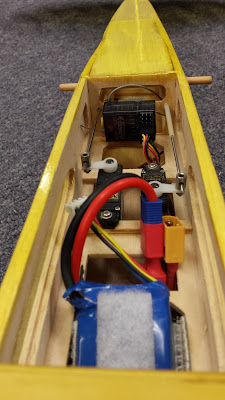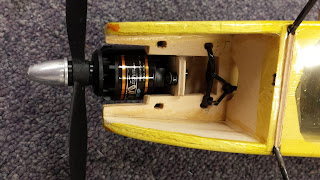This is the second and final part of the stability analysis of the Orr-Sommerfeld Equation. In my
previous post, I went through the derivation and nondimensionalization of the Orr-Sommerfeld Equation. In this part, I show how to perform the temporal and spatial stability analyses.
Blasius Velocity Profile
A 2-D Blasius boundary layer can be expressed as
$$\bar{U}=f'\left(\eta\right)\tag{1}\label{blasius}$$
where
$$\begin{align}\eta=y\sqrt{\frac{U_{\infty}}{2\nu x}}\\f'''+ff''&=0\\f(0)=f'(0)&=0\\f'(\infty)&=1\end{align}$$
This is a nonlinear ordinary differential equation that is most easily solved using a shooting method. In a shooting method, the boundary value problem is made into an initial value problem, whereby an initial guess of one parameter is iteratively updated until the opposite boundary conditions are met. In the present case, the unknown boundary condition is \(f''(0)\) , so it is iteratively adjusted until \(|f'(10)-1|\leq10^{-6}\). The present case uses a fourth-order Runge-Kutta method of integration. The initial condition The transformation of the Blasius velocity profile from \(\eta\) to \(\xi\) is performed by determining the distance from the wall, \(\delta\), where the stream-wise velocity is \(99.9\%\) of the free-stream velocity.
$$\begin{align}\bar{U}\left(\xi\right)&=\bar{U}\left(\frac{\eta}{\delta}\right)\\\bar{U}''\left(\xi\right)&=\frac{1}{\delta^{2}}\bar{U}''\left(\frac{\eta}{\delta}\right)\end{align}\tag{2}\label{transform}$$
The figure below shows the Blasius velocity profile and its derivatives.
Temporal Stability
The Orr-Sommerfeld equation can be analyzed for temporal stability by assuming that \(\bar{\alpha}\) is real. This enables us to rearrange the non-dimensional Orr-Sommerfeld equation as follows.
$$\left(-\bar{U}\bar{\alpha}^{2}-U''+\frac{i\bar{\alpha}^{3}}{Re_{\delta}}\right)\bar{\phi}+\left(\bar{U}-\frac{2i\bar{\alpha}}{Re_{\delta}}\right)\bar{\phi}''+\left(\frac{i}{\bar{\alpha}Re_{\delta}}\right)\bar{\phi}''''=\bar{c}\left(\bar{\phi}''-\bar{\alpha}^{2}\bar{\phi}\right)\tag{3}\label{realalpha}$$
If we discretize this equation using a finite difference approximation for \(\bar{\phi}''\) and \(\bar{\phi}''''\), we get an equation of the form
$$A\Phi=\tilde{c}B\Phi\tag{4}\label{eigmatrixform}$$
where \(\Phi\) is a vector containing values \(\bar{\phi}_{i}\) at discrete locations. This is nothing more than an eigenvalue problem, where \(\tilde{c}\) is a diagonal matrix of eigenvalues for the discrete system. The present calculations use a second order central differencing scheme to approximate the second and fourth derivative terms.
$$\begin{align}\bar{\phi}_{i}''&\approx\frac{\bar{\phi}_{i-1}-2\bar{\phi}_{i}+\bar{\phi}_{i+1}}{h^{2}}\\\bar{\phi}_{i}''''&\approx\frac{\bar{\phi}_{i-2}-4\bar{\phi}_{i-1}+6\bar{\phi}_{i}-4\bar{\phi}_{i+1}+\bar{\phi}_{i+2}}{h^{4}}\end{align}\tag{5}\label{eqfindiff}$$
At the boundaries, \(\bar{\phi}=0\), so the first and last columns of \(A\) and \(B\) are removed. However, \(\bar{\phi}'=0\) also at the boundaries. Fortunately, using a backward difference method at the boundary gives \(\bar{\phi}_{-1}\approx\bar{\phi}_{0}\), so the \(\bar{\phi}_{i-2}\) term can be omitted from the \(\bar{\phi}''''\) approximation just inside the wall boundary. Similarly, the \(\bar{\phi}_{i+2}\) term can be omitted just inside the free-stream boundary.
The finite difference approximations in Equation \ref{eqfindiff} gives a pentadiagonal \(A\) and tridiagonal \(B\).
$$\begin{align}A&=\frac{1}{h^{4}}\left[\begin{array}{ccccc}a_{11} & a_{21} & a_{3} & & 0\\a_{21} & \ddots & \ddots & \ddots\\a_{3} & \ddots & \ddots & \ddots & a_{3}\\ & \ddots & \ddots & \ddots & a_{2n}\\0 & & a_{3} & a_{2n} & a_{1n}\end{array}\right]\\B&=\frac{1}{h^{2}}\left[\begin{array}{cccc}b_{1} & b_{2} & & 0\\b_{2} & \ddots & \ddots\\ & \ddots & \ddots & b_{2}\\0 & & b_{2} & b_{1}\end{array}\right]\end{align}\tag{6}\label{fdmatrix}$$
where
$$\begin{align}a_{1i}&=h^{4}\left(-\bar{U}_{i}\bar{\alpha}^{3}-\bar{U}_{i}''\bar{\alpha}+\frac{i\bar{\alpha}}{Re_{\delta}}\right)-2h^{2}\left(\bar{U}_{i}\bar{\alpha}-\frac{2i\bar{\alpha}}{Re_{\delta}}\right)+6\left(\frac{i}{Re_{\delta}}\right)\\a_{2i}&=h^{2}\left(\bar{U}_{i}\bar{\alpha}-\frac{2i\bar{\alpha}}{Re_{\delta}}\right)-4\left(\frac{i}{Re_{\delta}}\right)\\a_{3}&=\frac{i}{Re_{\delta}}\\b_{1}&=-h^{2}\bar{\alpha}^{3}-\bar{\alpha}\\b_{2}&=\bar{\alpha}\end{align}\tag{7}\label{fdmatrixcoef}$$
The coefficients in \(A\) depend on the velocity profile, which varies with the distance from the wall. However, \(B\) is constant for a given \(\bar{\alpha}\). In addition, \(B\) is guaranteed to be real and symmetric, and is thus guaranteed to be invertible. We can thus left multiply Equation \ref{eigmatrixform} by \(B^{-1}\) and rewrite the equation as follows.
$$B^{-1}A\Phi=B^{-1}\tilde{c}B\Phi\tag{8}\label{newmatform}$$
It is clear that the eigenvalues of \(B^{-1}A\) are the eigenvalues in \(\tilde{c}\). Matlab's eig function was used to solve for the eigenvalues for each combination of \(\bar{\alpha}\) and \(Re\). The following figure shows the eigenvalues of the discrete system using one value of \(\bar{\alpha}\) and \(Re\). Each combination of \(\bar{\alpha}\) and \(Re\) gives a unique set of eigenvalues similar to these.

Because this is a stability analysis, we only care about the most unstable eigenvalue. The governing equation is related to \(e^{i\alpha(x-\left(c_{r}+ic_{i}\right)t)}\). If \(\alpha\) is real, then any instabilities must come from an eigenvalue with a positive imaginary component. For this reason, the interesting eigenvalue is the eigenvalue with the maximum imaginary component. This analysis was done over a range of \(\bar{\alpha}\) and \(Re\), and the most unstable eigenvalue was stored for each combination. Matlab's
contour function was then used to plot the contours shown in the following figure.
It is important to note that the contours shown here differ from those found by Wazzan in [7] because the Orr-Sommerfeld equation has been nondimensionalized in a different manner. The present case used the boundary layer thickness \(\delta\), while Wazzan used displacement thickness \(\delta^{*}\).
Spatial Stability
The temporal stability analysis is performed assuming that \(\bar{\alpha}\) is real. In the spatial stability analysis, we assume that \(\omega\) is real. It is possible to derive a polynomial eigenvalue problem for the eigenvalues \(\bar{\alpha}\), but solving the polynomial eigenvalue problem presented some challenges. Namely, at least one of the coefficient matrices was singular.

To circumvent this challenge, a mapping method has been used to give a relation between a complex \(\bar{\alpha}\) and a complex \(\omega\). In the present case, we hold \(\bar{\alpha}_{i}\) at a specific value and vary \(\bar{\alpha}_{r}\). For each \(\bar{\alpha}_{r}\), the discrete eigenvalue problem is solved for \(\omega\), and the most unstable eigenvalue is kept as before. By varying \(\bar{\alpha}_{r}\) with \(\bar{\alpha}_{i}\), a curve of \(\omega\) values can be plotted in the complex plane, as shown in the figure above. We then determine if there is an \(\bar{\alpha}_{r}\) that gives \(\omega_{i}=0\) and store any locations that satisfy this condition. This process is repeated for a range of \(Re\) for all interesting \(\bar{\alpha}_{i}\) values. The results of this process are shown in the figure below.
Discussion
This report is not the first on this topic, and the results do match fairly well with the references. Once the discretization was properly arranged, the eigenvalue computation was trivial using Matlab's built-in functions. Some factors added complexity to the project. The temporal stability curves are sensitive to the discretization step size and the number of \(Re\) and \(\bar{\alpha}\) values used. However, the spatial stability curves were far more sensitive.
It turns out that an insufficient number of \(\bar{\alpha}_{r}\) values will give bad resolution in the complex \(\omega\) plane, periodically overestimating the zero locations. This caused some oscillations at larger values of \(Re\). Additionally, a large number of Reynold's Number steps were required to ensure that the each of the desired contours were visible.Compounding the issue was the fact that an extra variable effectively raised computation time by nearly an order of magnitude.
References
- J. D. Anderson. Fundamentals of Aerodynamics. Aeronautical and Aerospace Engineering Series. McGraw Hill, 4th edition, 2007.
- M. J. Maghrebi. Orr Sommerfeld Solver using Mapped Finite Di fference scheme for plane wake fl ow. Journal of Aerospace Science and Technology, 2(4):55-63, December 2005
- P. J. J. Moeleker. Linear Temporal Stability Analysis. Technical report, Delft University of Technology, 1998. Series 01: Aerodynamics 07.
- B. S. Ng and W. H. Reid. Simple Asymptotics for the Temporal Spectrum of an Orr-Sommerfeld Problem. Applied Mathematics Letters, 13:51-55, 2000.
- S. A. Orszag. Accurate Solution of the Orr-Sommerfeld Stability Equation. Technical report, Massachusetts Institute of Technology, May 1971.
- T. Patel. Stability Properties of Self-propelled Wakes. Master's Thesis, University of California, San Diego, 2012.
- A. R. Wazzan, T. T. Okamura, and A. M. O. Smith. Spatial and Temporal Stability Charts for the Falkner-Skan Boundary-layer Profiles. Technical report, Douglas Aircraft Company, 1968.
- F. M. White. Viscous Fluid Flow. McGraw-Hill Series in Mechanical Engineering. McGraw Hill, 2nd edition, 1991.
Matlab Codes
These are the Matlab files needed to perform this analysis. Please feel free to use them as you will, but please give me credit. A link to my blog is always appreciated.











